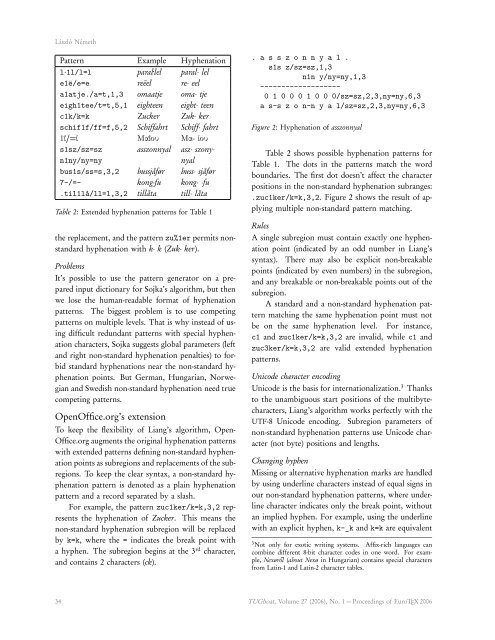The Communications of the TEX Users Group Volume 27 ... - TUG
The Communications of the TEX Users Group Volume 27 ... - TUG
The Communications of the TEX Users Group Volume 27 ... - TUG
You also want an ePaper? Increase the reach of your titles
YUMPU automatically turns print PDFs into web optimized ePapers that Google loves.
László Németh<br />
Pattern Example Hyphenation<br />
l·1l/l=l paral . lel paral- lel<br />
e1ë/e=e reëel re- eel<br />
a1atje./a=t,1,3 omaatje oma- tje<br />
eigh1tee/t=t,5,1 eighteen eight- teen<br />
c1k/k=k Zucker Zuk- ker<br />
schif1f/ff=f,5,2 Schiffahrt Schiff- fahrt<br />
1ΐ/=ί Μαΐου Μα-ίου<br />
s1sz/sz=sz asszonnyal asz- szonyn1ny/ny=ny<br />
nyal<br />
bus1s/ss=s,3,2 bussjåfør buss- sjåfør<br />
7-/=- kong-fu kong- -fu<br />
.til1lå/ll=l,3,2 tillåta till- låta<br />
Table 2: Extended hyphenation patterns for Table 1<br />
<strong>the</strong> replacement, and <strong>the</strong> pattern zu%1er permits nonstandard<br />
hyphenation with k- k (Zuk- ker).<br />
Problems<br />
It’s possible to use <strong>the</strong> pattern generator on a prepared<br />
input dictionary for Sojka’s algorithm, but <strong>the</strong>n<br />
we lose <strong>the</strong> human-readable format <strong>of</strong> hyphenation<br />
patterns. <strong>The</strong> biggest problem is to use competing<br />
patterns on multiple levels. That is why instead <strong>of</strong> using<br />
difficult redundant patterns with special hyphenation<br />
characters, Sojka suggests global parameters (left<br />
and right non-standard hyphenation penalties) to forbid<br />
standard hyphenations near <strong>the</strong> non-standard hyphenation<br />
points. But German, Hungarian, Norwegian<br />
and Swedish non-standard hyphenation need true<br />
competing patterns.<br />
OpenOffice.org’s extension<br />
To keep <strong>the</strong> flexibility <strong>of</strong> Liang’s algorithm, Open-<br />
Office.org augments <strong>the</strong> original hyphenation patterns<br />
with extended patterns defining non-standard hyphenation<br />
points as subregions and replacements <strong>of</strong> <strong>the</strong> subregions.<br />
To keep <strong>the</strong> clear syntax, a non-standard hyphenation<br />
pattern is denoted as a plain hyphenation<br />
pattern and a record separated by a slash.<br />
For example, <strong>the</strong> pattern zuc1ker/k=k,3,2 represents<br />
<strong>the</strong> hyphenation <strong>of</strong> Zucker. This means <strong>the</strong><br />
non-standard hyphenation subregion will be replaced<br />
by k=k, where <strong>the</strong> = indicates <strong>the</strong> break point with<br />
a hyphen. <strong>The</strong> subregion begins at <strong>the</strong> 3 rd character,<br />
and contains 2 characters (ck).<br />
. a s s z o n n y a l .<br />
s1s z/sz=sz,1,3<br />
n1n y/ny=ny,1,3<br />
-------------------<br />
0 1 0 0 0 1 0 0 0/sz=sz,2,3,ny=ny,6,3<br />
a s-s z o n-n y a l/sz=sz,2,3,ny=ny,6,3<br />
Figure 2: Hyphenation <strong>of</strong> asszonnyal<br />
Table 2 shows possible hyphenation patterns for<br />
Table 1. <strong>The</strong> dots in <strong>the</strong> patterns match <strong>the</strong> word<br />
boundaries. <strong>The</strong> first dot doesn’t affect <strong>the</strong> character<br />
positions in <strong>the</strong> non-standard hyphenation subranges:<br />
.zuc1ker/k=k,3,2. Figure 2 shows <strong>the</strong> result <strong>of</strong> applying<br />
multiple non-standard pattern matching.<br />
Rules<br />
A single subregion must contain exactly one hyphenation<br />
point (indicated by an odd number in Liang’s<br />
syntax). <strong>The</strong>re may also be explicit non-breakable<br />
points (indicated by even numbers) in <strong>the</strong> subregion,<br />
and any breakable or non-breakable points out <strong>of</strong> <strong>the</strong><br />
subregion.<br />
A standard and a non-standard hyphenation pattern<br />
matching <strong>the</strong> same hyphenation point must not<br />
be on <strong>the</strong> same hyphenation level. For instance,<br />
c1 and zuc1ker/k=k,3,2 are invalid, while c1 and<br />
zuc3ker/k=k,3,2 are valid extended hyphenation<br />
patterns.<br />
Unicode character encoding<br />
Unicode is <strong>the</strong> basis for internationalization. 3 Thanks<br />
to <strong>the</strong> unambiguous start positions <strong>of</strong> <strong>the</strong> multibytecharacters,<br />
Liang’s algorithm works perfectly with <strong>the</strong><br />
UTF-8 Unicode encoding. Subregion parameters <strong>of</strong><br />
non-standard hyphenation patterns use Unicode character<br />
(not byte) positions and lengths.<br />
Changing hyphen<br />
Missing or alternative hyphenation marks are handled<br />
by using underline characters instead <strong>of</strong> equal signs in<br />
our non-standard hyphenation patterns, where underline<br />
character indicates only <strong>the</strong> break point, without<br />
an implied hyphen. For example, using <strong>the</strong> underline<br />
with an explicit hyphen, k-_k and k=k are equivalent<br />
3 Not only for exotic writing systems. Affix-rich languages can<br />
combine different 8-bit character codes in one word. For example,<br />
Nexøről (about Nexø in Hungarian) contains special characters<br />
from Latin-1 and Latin-2 character tables.<br />
34 <strong>TUG</strong>boat, <strong>Volume</strong> <strong>27</strong> (2006), No. 1 — Proceedings <strong>of</strong> Euro<strong>TEX</strong> 2006

















